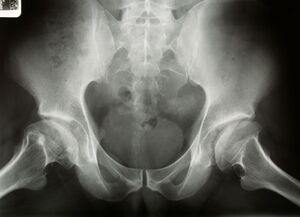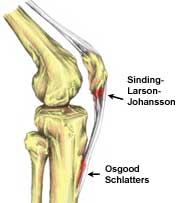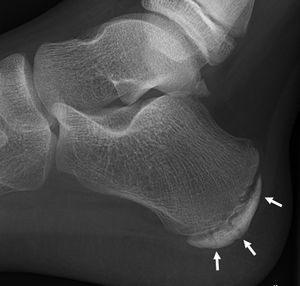Osteochondrosis
Original Editor - Lucinda Hampton
Top Contributors - Lucinda hampton, Naomi O'Reilly and Aminat Abolade
Introduction[edit | edit source]

Osteochondrosis is the descriptive term given to a group of disorders affecting an ossification centre in a child or adolescent resulting in alteration of endochondral ossification. These are usually self-limited conditions that often result in activity-related pain, which can at times be disabling. Treatment is based on the severity of symptoms and commonly includes restriction of activity. Diagnosis is made by history and physical exam in conjunction with radiographic findings.[1] [2]
Examples[edit | edit source]
Osteochondrosis affect different parts of the body and are typically grouped into one of three categories based on where they occur. They can be articular, physeal, or nonarticular. The commoner examples include:
- Articular osteochondrosis occurs in joint areas including:
- Legg-Calve-Perthes Disease (affects the hip);
- Kienbock Disease (affects the lunate carpal bone);
- Panner Disease (affects the capitellum);
- Freiberg Infraction (affects the second toe);
- Kohler Disease (affects the tarsal navicular of foot).
- Nonarticular osteochondrosis can affect any part of the skeleton.
- Osgood-Schlatter Disease (affects the tibial tubercle);
- Osteochondritis Dissecans of the Knee;
- Osteochondritis Dissecans of the Elbow;
- Medial Epicondyle Apophysitis;
- Calcaneal Apophysitis (commonly called Severs Disease) (affects the calcaneus);
- Sinding-Larsen-Johansson Syndrome (affects the proximal patellar tendon) [2]
- Spinal osteochondrosis occurs can affect any of the intervertebral discs and respective vertebral body endplates.
- Scheuermann’s Disease (affects the intervertebral joints of the spinal column).
Etiology[edit | edit source]
Osteochondrosis is predominantly found in children and teenagers up to approx. age 20. Children who partake in sports are more likely to develop osteochondroses. Found more commonly in boys, possibly because boys are at higher risk for injuries than girls.
Osteochondrosis has no single, known cause.
Common factors include
Physiotherapy[edit | edit source]
Depending on which type of osteochondrosis present the outlook varies. Osteochondroses often heal without treatment or with some minor help from eg. physiotherapy, braces or a cast, restriction of activity, and exercises. They often heal without treatment within weeks to a few months of their occurrence. See individual links for details.
References[edit | edit source]
- ↑ Science Direct Osteochondrosis Available:https://www.sciencedirect.com/topics/medicine-and-dentistry/osteochondrosis (accessed 12.10.2022)
- ↑ 2.0 2.1 Radiopedia Osteochondrosis Available: https://radiopaedia.org/articles/osteochondrosis (accessed 12.10.2022)
- ↑ Healthline Osteochondrosis Available: https://www.healthline.com/health/osteochondroses#causes-and-risk-factors (accessed 13.10.2022)








